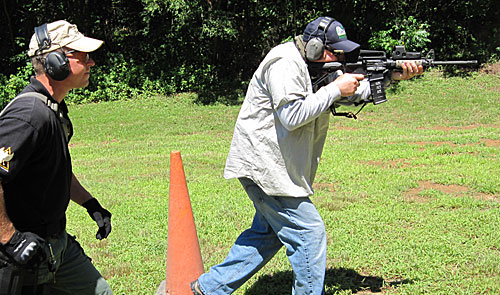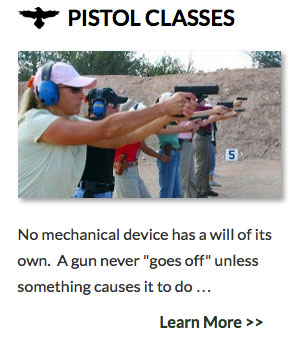Widgetized Section
Go to Admin » Appearance » Widgets » and move Gabfire Widget: Social into that MastheadOverlay zone
Should we shoot on the move?
 The legendary Bruce Lee said it well…” Advanced skills are the basics mastered”. Gunfighting is more than just punching holes in a target, though many students of pistol craft seem to ignore this. No one can reliably hit well enough to incapacitate an attacker unless they perform the essentials of grip, trigger control, weapon alignment, body position, etc. If one can’t perform these required skills, then they will never be able to shoot well enough to save their own life. Can you get lucky? Sure. But I would never choose luck over skill. It has been my personal experience the harder I work at a given skill, the luckier I seem to get.
The legendary Bruce Lee said it well…” Advanced skills are the basics mastered”. Gunfighting is more than just punching holes in a target, though many students of pistol craft seem to ignore this. No one can reliably hit well enough to incapacitate an attacker unless they perform the essentials of grip, trigger control, weapon alignment, body position, etc. If one can’t perform these required skills, then they will never be able to shoot well enough to save their own life. Can you get lucky? Sure. But I would never choose luck over skill. It has been my personal experience the harder I work at a given skill, the luckier I seem to get.
I become concerned when an instructor or school makes advanced skills out to be some “Secret of the Ninja” instead of a natural progression of training. The truth is, there are only so many ways to shoot a gun and they’ve all been invented… probably sometime between 1840 and 1940. Sure, these skills can be tweaked to look more “tactical” (whatever that is) with herky-jerky, spastic motions and manipulations that do nothing but add time and effort, but these don’t really improve anything. Oftentimes, they actually make a given skill harder to do. Spastic (but cool-looking!) body motion is actually slower than eliminating unnecessary motion. We’ve all heard the saying smooth is fast, and it s true. Smooth is eliminating unnecessary movement, which is what we should all strive for. Don’t strive to look cool. If you look cool but can’t hit what you’re shooting at, what s the point?
One of these advanced skills is shooting on the move or shooting while moving. Understand that this isn’t the same as shoot and moving. We’re talking about actually shooting the gun while in motion; the trigger finger and feet both in motion simultaneously. Many people have difficulty shooting a gun accurately while standing still, how well are they going to do while trying to move?
Delta Force veteran Sgt. Paul Howe, founder of Combat Shooting and Tactics in Texas, in his article Training for the Fight or Avoiding Fantasy Gunfight Training says “Reference shooting on the move, it’s a skill all shooters aspire to learn and spend a great deal of time and effort trying to master. I’ve never had to use it in combat. When moving at a careful hurry, I stopped, planted and made my shots. When the bullets were flying, I was sprinting from cover to cover, moving too fast to shoot. I didn’t find an in-between. If I slowed down enough to make a solid hit when under fire, I was an easy target, so I elected not to.” So, just how important is shooting on the move? Should we try to do it at all? As Sgt. Howe alludes to, there is no way to know because, like many things in armed conflict, it will be “situationally dependant”. Is it important to shoot accurately or move quickly? How close are you to the attacker? Will movement solve a problem or accomplish a given goal?
Howe deployed to hot spots all over the world and was on the ground during the famed Blackhawk Down incident. His words are worth considering. After all, how fast do you really travel when shooting on the move? Is it fast enough that you’d use the technique if bullets were inbound, striking you in the chest and head? After all, not getting shot is the goal of any combative firearms tactic.
At this point, I may have ticked off a number of you because I’ve shaken your tactical belief system. There are too many people who want to believe something just because someone you respect says so…don’t do it! Think carefully as it is your life on the line. That said, stay with me… there is a point to this.
Think about this: How is shooting on the move taught on the square range? Back and forth, side to side in a very controlled manner for safety reasons. Your first shooting/moving drill was probably a “box drill” which is an efficient method to teach the technique, but it is a drill not movement as it will be used in conflict. Also keep in mind a line of students pointing their guns are liable to point at each other, so movement is strictly controlled. “Groucho (Marx) walking” or heel, ball, toe are usually discussed, but let me remove some of the mystery.
If you’ve ever filled your coffee cup too full, you’ve probably shot on the move or at least performed the body motion. Maybe you stopped at a convenience store on the way to work and filled your coffee cup to the brim and really didn’t want to pour it out. You might have taken a sip, and then extended the cup out from your torso and lowered your center of gravity (hips) by bending your knees. You then smoothly walked heel, ball, toe to the check out working hard not to spill the hot liquid on your hand. If this sounds familiar, congratulations! You’ve shot on the move going forward. Instead of trying to stabilize the hot beverage, you’re now trying to stabilize a firearm but it is the same action. But how fast can you move and fire an accurate shot? Think trigger control is hard to master? Wait until you try to walk at the same time. Moving forward is the most common methodology for shooting on the move with the shooter closing on their target. Read this getting closer to the person shooting at you! Doesn’t this enhance your opponent’s accuracy? It is true that an aggressive attack might overwhelm an opponent so knowing how to do this is not a waste of effort, but with all things there are advantages and disadvantages.
Going backward is worse, because the body isn’t designed to do this. There are no eyes in the back of your head, and feet, knees and hips are all geared to move forward. In order to move smoothly to the rear (remember we’re shooting), we must use some type of shuffle step or step-and-drag motion to keep the gun stable and fire an accurate shot. How fast can you do this and not fall? Remember: Bullets are inbound and if you fall back and are shot up through the rectum long wise through the torso, you are probably dead. Having spoken with a number of cops who have attempted this in real gunfights, I’ve found that in no time at all, their ass overrode their feet, and they fell, unless they turned their body and rotated their upper torso shooting back one-handed as they moved. Have you ever practiced shooting on the move in this fashion?
How about the much-vaunted lateral movement? The truth is getting off the line of attack does work, but the single lateral step as taught on many square ranges doesn’t accomplish this. Also, a single step will not “fake out” someone attacking you like many want to believe. If you don’t want to believe this, try it for yourself. Have a friend stand 15 to 20 feet away and charge while trying to side step them like a Matador. I’ve been demonstrating this to classes for years and I have not faked out a student yet. Lateral movement, to be effective, must be explosive, dynamic and without hesitation, moving as far as the environment will allow and is more likely to work if you (the opponent is 12 o’clock and you’re 6 o’clock) move in a 2-or-10-o clock direction, drawing and shooting as you go. This is hard to train on a square range when there is a line of shooters, but it’s more realistic than the entire line moving a single step in each direction. Movement in conflict needs to be aggressive regardless of the direction traveled.
How do you train? Is your movement slow and controlled so you can get tight groups? Remember: You will default to your level of training in armed conflict. Airsoft and Simunitions can be helpful. Although many think of these devices as scenario-based, they can be a big help in anchoring combative firearms skills. Example: If you want a shooter to explosively move off the line of attack as he draws, have his attacker shoot him. There is nothing like pain to make your point. Doing so gets them to respond to an aggressive visual queue… something that actually looks like an attack. It also gets them to understand that these situations are over quickly, and the only way to get out in front is to be explosive, aggressive, dynamic and accomplished. Luck isn’t enough.
Do we need to practice shooting on the move? You bet, but it needs to be goal-oriented. The only reason to move in a fight is because it offers some advantage. At a minimum, a moving target is harder to hit (a worthwhile goal in itself), and shooting while moving may get us to hard cover. What’s cover? It depends on what we’re being shot at with, a 9mm pistol or an AK-47. That’s a good thing to know before you move.
While moving forward is the most commonly taught technique, moving away is probably more useful but as previously stated moving backward is contrary to how we humans are built. Moving more than 10 or so feet to the rear is likely to result in falling, so try combining rearward movement with turning the feet/legs in the direction you want to move, and rotate the torso to the rear. This works pretty well and allows for more rapid movement. Offline movement is a good skill to have, but short movement is designed to end the threat quickly by getting ahead of your attacker’s action/response curve by doing the unexpected. This type of lateral motion will not be extensive so be prepared to end the fight quickly! Explosive side movement at an angle, while delivering accurate fire, will certainly help you prevail.
Also keep in mind that shooting AND moving can be a viable tactic. When performing this, the shooter moves as fast as possible but when they need to shoot the stop, plant and deliver accurate fire only to move rapidly as soon as they are off the trigger. In some of the classes I teach, I will have two students travel the same distance, one shooting on the move while the other is shooting and moving. The rest of the class watches to see who finishes first and then checks the accuracy of each target. They usually understand the importance of practicing both skills.
I realize that this column might anger more than a few, but the primary mission of my training company is to help the good guys and gals win on the street, not win the “most popular instructor award”. Often this requires critical analysis on the part of every student. Remember: Shooting while moving is so much more than a cool range drill. It s a valid technique that must be taught, learned and mastered in one’s real world of work. It might not be a matter of can I shoot on the move, but should I?
About the author:
 Dave Spaulding is the 2010 Law Officer Trainer of the Year and Law Officer’s Firearms columnist. A 28-year law enforcement veteran who retired at the rank of lieutenant, he is the founder of Handgun Compatives. He has worked in corrections, communications, patrol, evidence collection, investigations, undercover operations, training and SWAT—and has authored more than 1,000 articles for various firearms and law enforcement periodicals. He’s also the author of the best-selling books Defensive Living and Handgun Combatives. Visit his web site at www.handguncombatives.com and like him on Facebook.
Dave Spaulding is the 2010 Law Officer Trainer of the Year and Law Officer’s Firearms columnist. A 28-year law enforcement veteran who retired at the rank of lieutenant, he is the founder of Handgun Compatives. He has worked in corrections, communications, patrol, evidence collection, investigations, undercover operations, training and SWAT—and has authored more than 1,000 articles for various firearms and law enforcement periodicals. He’s also the author of the best-selling books Defensive Living and Handgun Combatives. Visit his web site at www.handguncombatives.com and like him on Facebook.



 MidwayUSA
MidwayUSA Ruger Firearms
Ruger Firearms SCCY Firearms
SCCY Firearms Streamlight
Streamlight Action Targets
Action Targets Gunsite Academy
Gunsite Academy
You must be logged in to post a comment Login